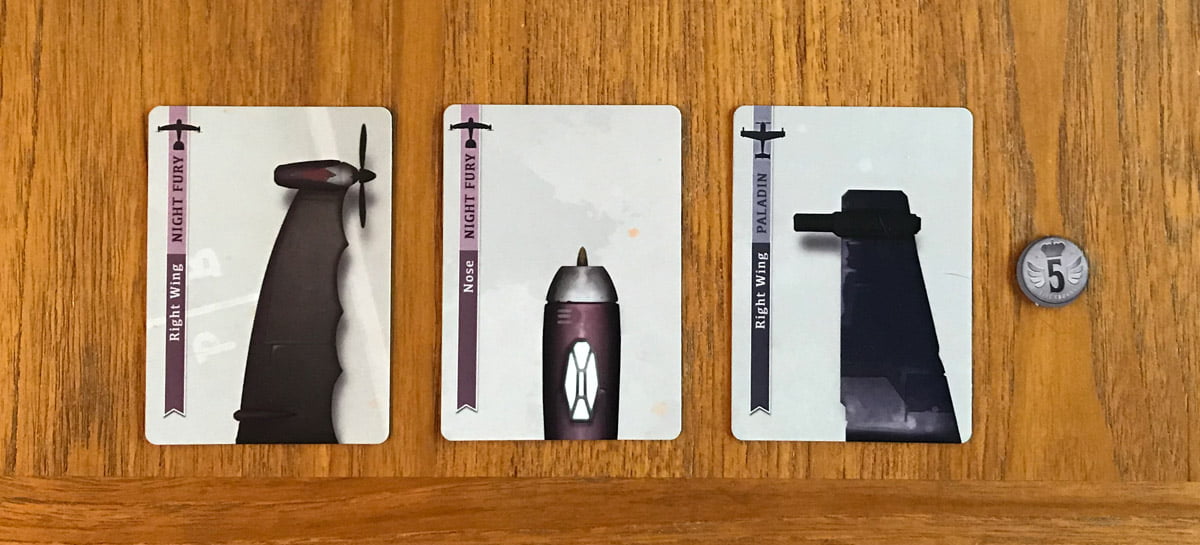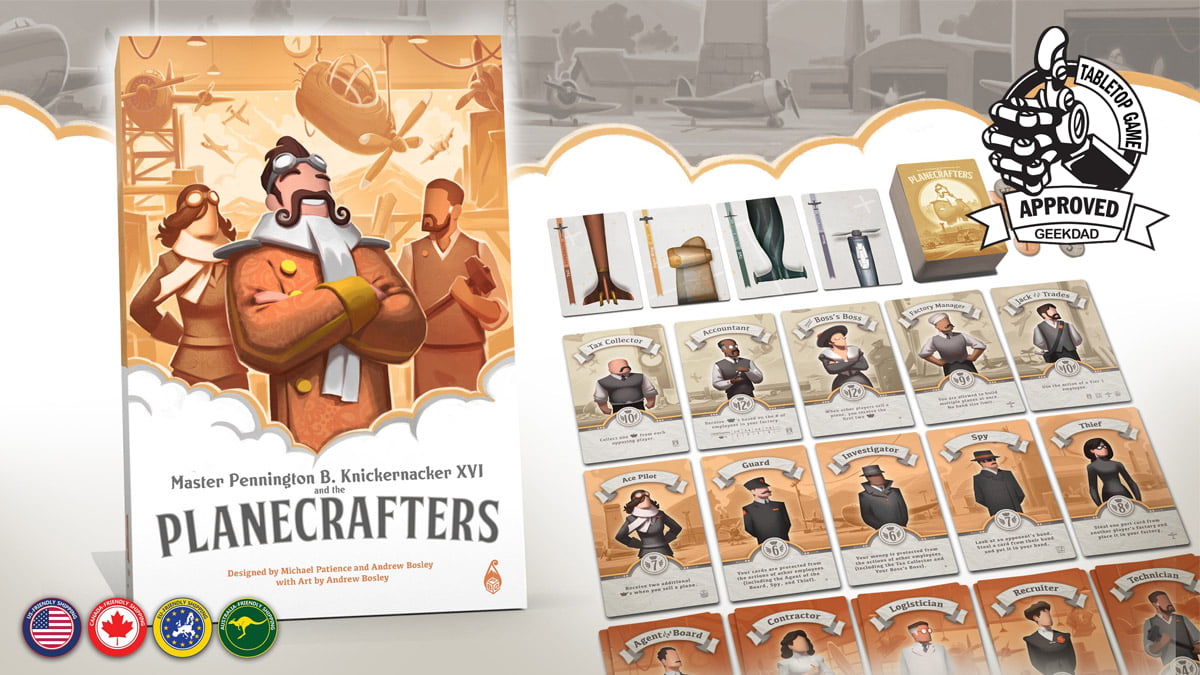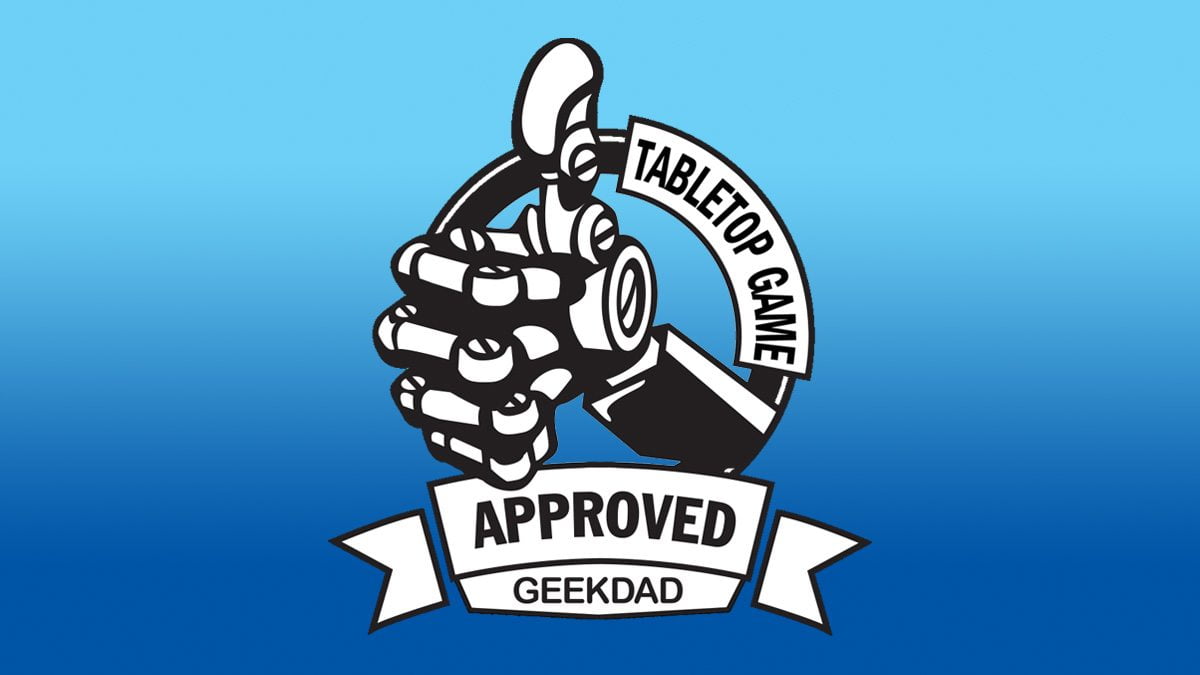
Set in the early days of aviation, Crumplehorn is a small nation bent on keeping up with world development, and has turned to the ingenious Master Pennington B. Knickernacker XVI to help them do it. His team of Planecrafters (the players) race to build planes to keep up with demand and, of course, make some money along the way. Planecrafters launched on Kickstarter today, and is now available for backing. If you are going to back a single Kickstarter in 2018, it simply must be Planecrafters.
What Is Planecrafters?
Planecrafters is a 2-4 player game, for players aged 9+. We recommend ages of at least 6+, as there is some addition and patience required. The theme is perfectly family friendly, with notes of silly for kids and some heavy strategy options for adults. Playtime varies widely based on the number of players, skill, familiarity with the game, and ages of players. Most games run us a bit over 20 minutes.
New to Kickstarter? Check out our crowdfunding primer, and visit our Kickstarter curated page for more projects we love.
Planecrafters is GeekDad Approved!
Planecrafters Components
- 112 Poker-sized Part cards
- 20 Tarot-sized Employee cards
- 4 Player Aid cards
- 3 Oversized Awards cards
- 28 Value 1 Crowns
- 15 Value 5 Crowns
- 15 Value 10 Crowns
Planecrafters is composed of nearly 200 pieces. Components include cardboard coins and cards of different sizes. The quality of the pieces is decidedly satisfactory, though there will be stretch goals to improve the quality of the pieces even more. The cards are sturdy and feel nice in the hand. Coins are 1.5mm, which isn’t a thin weight, but doesn’t have the heft to make them feel more like regular coins. An early stretch goal will be to increase the thickness, which will give give them a bit more substance for fidgeting with.
A significant factor for me is the box. I, like many passionate gamers, have far too many games to waste box footprint. Thankfully, Planecrafters comes in a tidy small-ish box, appropriately sized for a tabletop game without a board. Another early stretch goal will be for an insert. I’ve seen a prototype, and I am excited that the stretch goal is a modest $25k. I love being able to stand a game on end like a book, and the insert should enable that kind of storage without the cards and coins becoming jumbled.
How to Play Planecrafters
The Goal
Players compete amongst themselves to build the most efficient and profitable of Knickernacker’s designs. Players build planes with the Parts cards which feature a Nose, Tail, Left Wing, Right Wing, and Fuselage (optional). Selling planes nets an income of Crowns (coins) which can be used to hire Employees. At the end of the game, players tally their Crowns and add any Awards received to the total. The highest total wins, and in case of a tie, the player who had the last (or closest to last) turn wins the tie.

Setup
The setup of the game is pretty simple. You will need some space to play, but any standard table is fine. The tarot-sized Employees are organized by tiers, while the poker-sized deck of Parts cards are placed at the bottom or to one side, your preference. Crowns (coins) are set to the side as a bank, and the Awards are also set to the side.

Players begin the game able to take full advantage of a turn. Unlike some games, there’s no need to go a round (or six) before getting to the meat of the game. To keep things fair, Parts cards are dealt in increasing numbers. The first player will always start with the fewest cards, and the last player will always start with the most. The hands are dealt before the Parts Depot (the area with face-up Parts cards) is dealt.
Players are also given 5 Crowns apiece when the cards are dealt.
Employees
The Employee cards are the heart of the strategy in Planecrafters. Each Planecrafter (player) can hire 1 Employee per turn, which change the limitations of the player’s turn. While Planecrafters isn’t an engine-building game, the Employees drive the game with their unique abilities and synergy, which complement different strategies and play styles.
Employees, once hired, are in your factory for good. They require no upkeep and cannot be stolen or removed by any means. They are, effectively, a permanent upgrade.

Tier 1 Employees include 2 Agent of the Board, 2 Contractor, 2 Logistician, 2 Recruiter, and 2 Technician cards. Each has an early-game impact, which continues to be meaningful throughout the game. The Agent of the Board, for example, allows you to swap your hand (of any number of cards) with another player. These Employees must be chosen carefully, as there are only 2 of each, and getting the Employees you want must also be tempered with keeping cards out of the other players’ factories (play area). While no player needs all five of these Employees, having only one can be crippling to your chances to win.

Tier 2 Employees include the Guard, Investigator, Ace Pilot, Spy, and Thief. Each of these cards changes the game in a more subtle way. The Guard can prevent the Agent of the Board’s effect, so in a 2- or 3-player game, the guard can completely disrupt the strategies of other players. The Ace Pilot is a much-envied card regardless of strategy, as she gives you more Crowns with every sale, ensuring a wealthy future.

Tier 3 Employees include the most expensive and game-changing cards on the field. The Factory Manager removes the hand limit size, and Your Boss’s Boss allows you to scrape off the first 2 Crowns from any sale. The most versatile card, though, is the Jack of all Trades. He can copy the effects of any Tier 1 Employee, helping any given player gain the critically-needed assistance of Employees who were snapped up by other players.
Gameplay
Play in Planecrafters is deceptively simple, and rich with possibilities. Turns have 4 straightforward steps, called Hire, Acquire, Flyer, and Buyer. Players can Hire Employees, Acquire new Parts cards (2 by default, more if Employees help), build a Flyer (that is, a plane), and contact the Buyer, Master Pennington, to sell their planes. Pennington is not a picky man, and will take planes even if they’re all mixed up and look strange. Finally, players make sure they’ve got no more than 5 cards in their hand, discarding to the deck any over the hand limit.
The game ends when the last Parts card is drawn from the deck, either to refill the Parts Depot or drawn into a player’s hand. The Planecrafter finishes their turn, and the round is finishes, so all players have the same number of turns.

The First Turn of the Game
A quick walkthrough: The first player begins with 3 Parts cards and 5 Crowns. The game is not typically played with the hand face up; this is just for demonstrative purposes.

Player Joe spends 4 Crowns to Hire a Contractor during the first phase of their turn. The Contractor is an important Employee in any factory, as she allows you to sell planes most every turn, regardless of whether the plane is complete.

Next Joe Acquires 2 new cards. They can be picked from the Parts Depot, which are the face-up cards, or they can draw face-down cards from the deck directly, if they don’t like the Parts in the Depot. Spare Parts (wild cards) can be picked up from the Parts Depot, but are likely to be picked up immediately. If the cards in the Parts Depot aren’t ideal for your plan, drawing the unknown face-down cards may be appealing.

Next, the Planecrafter builds their Flyer. On a normal turn, the player can play only 2 Parts. In this example, the Planecrafter places a Night Fury Nose and a Night Fury Right Wing. Since these pieces match, the plane will be more valuable.

Next the Planecrafter contacts the Buyer (thematically—no action required for this), and sells the plane. Because this plane was incomplete, the player in the example was only able to sell it with the assistance of the Contractor. In this case, the plane is worth 3 Crowns, bringing Joe back up to 4. He will now be able to Hire another Tier 1 Employee on his next turn.
Scoring a plane is fairly straightforward. Depending on how many matching pieces are in the plane, scoring goes as follows:
1 Part of a model is worth 1 Crown.
2 matching Parts are worth 3 Crowns together.
3 matching Parts are worth 6 Crowns together.
4 matching Parts are worth 10 Crowns together.
5 matching Parts cards (a complete plane) is worth 15 points.
Spare Parts are always worth only 1 point, and do not count as a match with any design.
After scoring, the plane is set to the side. Because this is the first sale, the plane has the Distinction Award attached. (The image has the wrong Award placed—my mistake). The Distinction Award goes to the player with the highest cost plane. To keep track of the plane’s value, we keep extra Crowns on the Award equal to the value of the plane. This Award will wander around the table throughout the game, being picked up each time a more valuable plane is played.
It’s important to note that the Distinction Award only moves to another player if they sell a more valuable plane. This means that the first player to sell a plane worth 15 points (the highest possible value) will gain the Award and it cannot be taken away.
This ends Joe’s turn, since he has fewer than 5 cards, and play passes to his left.

Awards and Coins
The Awards cards are earned by being the best factory in a given category, and can upset the scores much like Dumbledore in his end-of-term speeches. This is because each Award is worth a whopping 8 Crowns. The Industry Award and Enterprise Award remain in dispute until the very last turn, but the Distinction Award is passed around during play.
There are plenty of Crowns to go around, and we’ve never run short on them during play. They are quality game pieces, and even if the stretch goal to improve them is not funded, the current quality level is standard at worst.
Planecrafters: The Verdict
The number one thing I want readers and potential backers to take away is that this is the perfect family game. The mechanics are simple. The theme is attractive and has no hint of adult or violent themes. The art is stunning. The game makes sense to anyone sitting down to play and takes one minute, perhaps less, to teach to a new table. </a>
Strategies
Perhaps the best part for serious gamers is the depth of play available with such simple mechanics. Once you pass the basics, you can create ways to maximize each turn, Hire the right Employees, and keep the income pouring in over time. For those of us who game to the max, Planecrafters is packed full of opportunities to be efficient, generate novel solutions, and out-think the competition in a way that is refreshing and never turns stale.
Major strategies include pursuing Awards for big payoffs and hiring the best Employees to get the job done. Even heavy-strategy game tables, some strategists do well ignoring both the Awards and the Employees, focusing on amassing wealth as steadily as possible.
The Distinction Award, as mentioned above, is for the most valuable plane. The only strategy for this Award is to work diligently to get the cards needed to build a 5-Part matching plane.

In order to build a plane with 5 matching Parts, you must select one of the planes which has a Fuselage. Not all planes are equal in this! The Big Boy has only 4 Parts total, and can only ever come to 11 Crowns, if it uses a Spare Part or Fuselage from another plane. The Goliath, on the other hand, has 5 matching Parts. A complete Goliath plane is worth a total of 15 Crowns.
Selling these expensive planes also grants Crowns, which means one can Hire more Employees, or stock up for end-of-game scoring.
The Industry Award is awarded to the player with the most total Parts sold. The only strategy here is to sell lots of planes, regardless of value. Selling a plane every turn is critical to gaining this Award. Employees like the Logistician, Contractor, and Technician can make all the difference in the race for this Award.

Players vying for the Industry Award will sell many planes which are mixed up or incomplete. The Big Boy/Paladin pictured above is worth only 6 points, but as it is 4 Parts sold, is still valuable for this strategy.
The Enterprise Award is given to the player with the most valuable Employee pool. To win this one, the best strategy is to keep other players from getting the more valuable Employees. The only way to do this is to buy them yourself, of course. Cards like the Recruiter and Accountant go very well with this strategy.
Employee Combos
Regardless of your strategy, many Employees do much better when paired with another Employee, which is the bulk of strategy in Planecrafters. One major component of potential strategies is combining Employees from different Tiers, but Employees from the same Tier can be invaluable to a well-rounded strategy.{

The Contractor/Ace Pilot combo helps generate a lot of Crowns from fairly early on in the game. This is because you can sell a plane on every turn, and each plane sold is worth 2 additional Crowns per sale.
The Recruiter/Accountant combo helps you snap up Employees and rewards you for doing so. If you have the accountant, it’s okay to miss out on the Enterprise Award. You will gain points based on the number of Employees you have hired, regardless of value. The points awarded are equal to the number of Employees divided by two, and rounded up. If you have 10 Employees, you will get 5 Crowns at the end of the game, guaranteed.
The Agent of the Board/Factory Manager combo is a strategy meant to control the Factory battlefield. The Agent of the Board helps you get massive numbers of cards each turn by stealing them from other players, and the Factory Manager allows you to build the perfect 5-matching-piece plane without losing out on sales while you collect the cards you need.

Sometimes, two Employees from the same tier pair especially well together.
The Technician/Logistician combo helps you both draw and play an extra card each turn. This helps players cycle through many Parts and planes. With a Spare Part and one Technician, a player could play a complete plane on one turn, as Spare Parts don’t count as a played card.
The Guard and Investigator prevent aggressive players from preying on you. If you’re the aggressive player, snapping these both up will guarantee you can always target whomever you like.
The meanest and most expensive combination of Employees is Your Boss’s Boss/Tax Collector. With these two, you can cripple other Planecrafters while milking Crowns off of their success. The only counter to these two is the Investigator, so only one player might be immune to these effects. It’s worth noting, however, that buying two Tier 3 Employees is not a common occurrence. By the time you’re buying Tier 3 cards, the deck is going to run low on Parts, and the game will be ending soon. Save up money instead, in order to beef up your point pool.

Employee MVPs and My Strategy
The Employees I go for, in order of importance, are the Contractor, Logistician, Recruiter, Investigator, Tax Collector, and Your Boss’s Boss. The Contractor immediately allows you to sell a plane, guaranteeing you’ll have 4 Crowns to Hire the Logistician. The Logistician, in turn, allows you to play an extra card. Now I can sell a plane every turn and keep hiring Employees. The Recruiter means I pay less for more expensive Employees. The Investigator is also 4 Crowns with the Recruiter in play, so my solid play of playing 3 Parts and selling the incomplete plane will carry be through my first 4 Employees. Once I have the Investigator to protect my coins, I begin saving them up, hiring the Tax Collector or Your Boss’s Boss if it looks like they’ll pay for themselves.
Planecrafters has quickly become one of my favorite games of all time. I’ve found myself playing the prototype with dozens of people. I don’t even care who I play with, it’s just good fun. I can comfortably add that Planecrafters is an all-star game from an all-star team. If future Paisley Game publications are like this, I will be supporting every one of them.
The lowest backing level is $8 for the print-and-play, which will be available beginning in August 2018. For $30, you get the print-and-play edition of Planecrafters in August, and a hard copy of the final production in January 2019. Higher backing levels were not announced prior to the publication of this article, but you can check them out on the Planecrafters Kickstarter.
Trust me, kids, Dad, Mom, game night: you’ll play with anyone to get to play another match of Planecrafters.
Click here to see all our tabletop game reviews.
![]() To subscribe to GeekDad’s tabletop gaming coverage, please copy this link and add it to your RSS reader.
To subscribe to GeekDad’s tabletop gaming coverage, please copy this link and add it to your RSS reader.
Disclosure: GeekDad received a copy of this game for review purposes.






